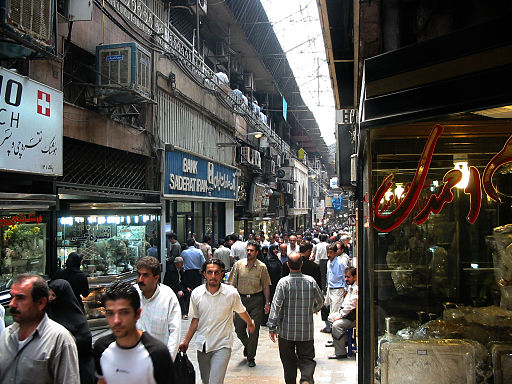 Teheran Grand Bazar (Wikimedia)
Teheran Grand Bazar (Wikimedia)
Last week’s (April 2, 2015) framework deal between the P5+1 nations (U.S., U.K., France, Russia, China + Germany) and Iran paves the way for Iran’s re-emergence into the world economy. Should a long-term agreement be made early next summer there would be the gradual lifting of international sanctions, particularly in banking, which would potentially energize and enrich Iran’s listless economy.
But would an influx of capital and free exports create major economic growth and prosperity for the country?
While Iran has a vibrant private sector, in many ways it can be compared to China in the late 1970s prior to Reform and Opening Up. To begin with the state is very much in the economy, and many industries have yet to be privatized. Secondly, much like China’s People’s Liberation Army, Iran’s Islamic Revolutionary Guard Corps has its hands in a number of industries across the economy. To further complicate things, there are the Bonyad, or charitable trusts, which likewise are in all types of businesses, and are repeatedly criticized as bloated and inefficient.
With such a quagmire of economic retardants in place, would even a total lifting of sanctions and the influx of capital create a new golden age for Iran’s economy?
On the plus side, Iran has a lot going for it. Number one is a young population. Estimates suggest that up to two-thirds of the population is under 30. ( Currently unemployment is high, and these young people who could drive a vibrant economy are going abroad creating a “brain drain” within Iran.) Iran has huge oil and gas reserves as well as the world’s second largest store of copper. Iran also has a substantial auto making industry and has the largest mobile phone market in the Middle East.
The potential for a re-invigorated Iran is an attractive proposition. Iran’s self-interest could be aligned with that of its regional neighbors and world partners.
Critics hold that the new Iran would not necessarily be politically different.
One of the problems in the West is the habit of seeing Iran as a monolith, just as “Red China” was seen as a monolith in the 1960s. The Wall Street Journal points out in an April 3 article that those in Iran making the nuclear deal in Switzerland are different from those making regional politics.
So for Iran, will prosperity come soon, and how will prosperity look? These are the big questions. Will prosperity empower Iran’s young population and create a new political climate? Will Iran take the China road? Or will this chance be lost? For the sake of the people in Iran, the region and the world, we hope not.
http://www.wsj.com/articles/prospect-of-bolder-iran-unnerves-some-encourages-others-1428084595
 日本語
日本語 English
English 中国語
中国語